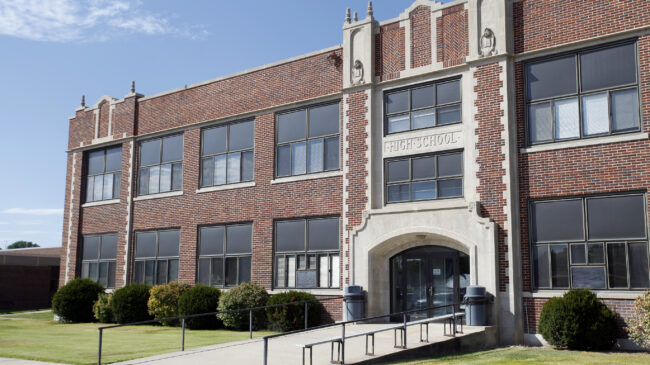Residential assignment has long constrained student opportunities because it intertwines schooling and housing. All too often, access to a better public education depends on a family’s ability to move to a more expensive neighborhood.
In fact, the median cost of housing in zip codes associated with highly ranked public schools was four times higher than the median cost of homes in zip codes associated with the lowest ranked public schools, according to a 2019 report by the Senate Joint Economic Committee.
When the price of admission to a public school is built into the cost of housing, mortgages function like fees to a private school. Accordingly, residential assignment’s de facto sorting mechanism—property wealth—often isolates students into socioeconomic enclaves.
New research from Harvard University Economics Professor Raj Chetty explains why this segregation sets low-income students up for failure. His work, Social Capital Volumes I and II, shows that schools are important institutions where students form key social networks and explains how cross-class interaction can form “‘bridging’ social capital,” which is most closely connected to upward mobility. In fact, Chetty finds that students with more cross-class interactions, or economic connectedness, are more likely to rise out of poverty.
Chetty’s research identifies two equally important factors that affect good economic connectedness: exposure to higher-income individuals and friending bias. Exposure to higher-income individuals at school can translate into upward mobility because students have more opportunities to build relationships with people with high social economic status.
Unfortunately, residential assignment is a major barrier to economic connectedness for many students because it limits their exposure.
“About half of the social disconnection between low- and high-income Americans is due to differences in exposure. For example, high-income people attend high schools that are disproportionately attended by other high-income people,” Chetty observed.
Weakening the ties between housing and schooling through school choice, including K-12 public school open enrollment, could be a key way to provide students with greater exposure.
Open enrollment lets students enroll in any public school with open seats regardless of where they live. Strong open enrollment policies operate as a form of public school choice and provide pathways for children to transfer to schools that are a better environmental fit, are safer, or offer AP courses and specialized curricula. For instance, Reason Foundation research showed that families in Texas and Florida use open enrollment to find better educational opportunities for their children.
Most importantly, however, Chetty’s work shows how open enrollment could give more students the opportunity to achieve the American dream.
Overcoming residential assignment barriers is key to student-centered education. Government-imposed boundaries wrongly lock students into geographic monopolies, limiting their education options. Not only could these students access education options that are the right fit via robust open enrollment policies, but students could also unlock the social networks that are crucial to upward mobility.
From the States: Education initiatives on statewide ballots this November
In Massachusetts, voters may impose an additional 4% tax on incomes over $1 million. The new revenue would fund K-12, college, and university education, as well as public transportation spending. Massachusetts already spends more than $21,000 per pupil on K-12 education and has increased total education revenue by 26% in the last two decades, despite experiencing a 6% enrollment loss.
California voters will have the chance to approve or deny an initiative that would earmark at least 1% of all state and local tax revenue from public schools exclusively to arts programs. Proposition 28’s opponents are wary of tying local school district leaders’ hands through “ballot-box” budgeting, especially as public school student enrollment declines. The state’s Legislative Analyst’s Office proposal estimates Prop. 28 would cost $800,000-to-$1 billion annually. The proposal comes after California allocated an additional $9 billion to its public school system in 2022.
Illinois voters will choose whether or not to add workers’ collective bargaining rights to the state constitution via Proposition 1, which is supported by teachers’ unions, among others. Critics say, if the proposition is passed, public sector unions would be given a newly-created constitutional right that would allow them to negotiate on a potentially limitless list of subjects and potentially block all future laws and reforms that might impact them.
In Idaho, a ballot initiative to increase education spending by more than $300 million through new corporate and individual taxes, even if approved, will now be voided following this month’s emergency legislative session. Gov. Brad Little signed a bill with a sales tax-funded annual spending increase of $330 million for K-12 schools, which will effectively replace the ballot initiative. Pressure to reform Idaho’s funding system overall was a frequent subject of the emergency session’s debate.
What to watch
School spending vs. student enrollment
Data from Burbio released this month tracks enrollment declines in districts across the country, from Los Angeles to Fairfax, VA. It shows how severe many school districts’ enrollment declines have been since the pandemic started. Yet, while enrollment numbers are declining, education spending continues to increase in most states. This latest data mirrors education spending and enrollment trends seen well before the pandemic. For example, New York increased inflation-adjusted public school spending by over $26 billion between 2002 and 2020 while losing 10% of its student population over that time.
Arizona school choice opponents fail to prevent education savings accounts expansion
The Arizona citizen’s referendum led by Save Our Schools (SOS), appears to have failed to block the nation’s biggest expansion of education savings accounts (ESAs). Despite its initial claim of gathering 141,714 signatures last Friday, this week, SOS all but conceded that its collected signatures fell well short of the 118,823 needed to overturn the law. This reversal occurred after the Goldwater Institute released projections that SOS was likely to have submitted approximately 88,866 signatures. Arizona’s secretary of state is expected to release the final signature count in mid-October.
Corey DeAngelis: Why the COVID-19 pandemic changed the face of education forever
In a new ReasonTV interview, Corey DeAngelis explains why “backpack funding” is here to stay, why Texas is terrible on school choice, and why even non-parents should care about education reform.
Recommended Reading
On a Per-Student Basis, School Staffing Levels Are Hitting All-Time Highs
Chad Aldeman at The74Million
“In the 2020-21 school year, staffing levels hit all-time highs, and the typical public school district employed 135 people for every 1,000 students it served.”
‘Flagrantly Illegal’: Law Firm Files Lawsuit To Stop Biden’s Student Loan Forgiveness
Robby Soave at Reason
“President Joe Biden’s plan to forgive hundreds of billions of dollars in student loan debt violates both federal law and the Constitution, according to a just-filed lawsuit from the Pacific Legal Foundation.”
The End of School Reform?
Chester Finn, Jr. and Frederick Hess in National Affairs
“It goes without saying that opportunities for agreement are difficult to spot right now, and such a coalition would have to pull against the centrifugal forces of polarization — a marked contrast to the previous era in which prominent politicians and advocates found centrism a source of political reward.”

